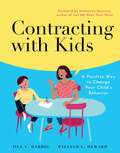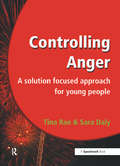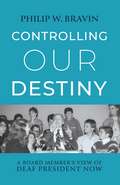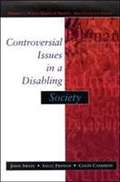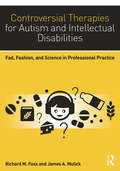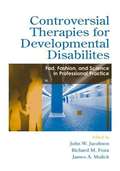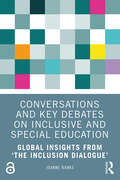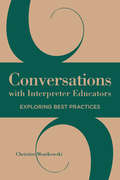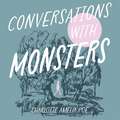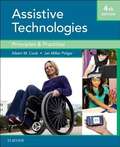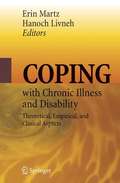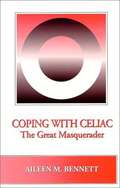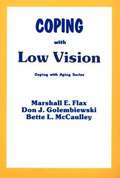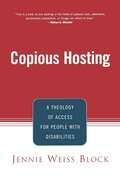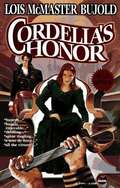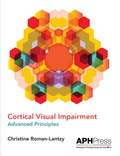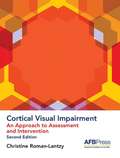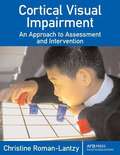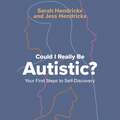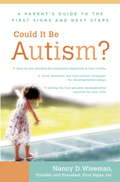- Table View
- List View
Contracting with Kids: A Positive Way to Change Your Child's Behavior
by William L. Heward Jill C. Dardig"Colorful and easy to implement, this book will be a resource for parents and guardians looking to try behavior contracting in their homes." —Library Journal When a child is struggling with a behavior challenge or wants to learn a new skill, a contract can be a surprisingly effective solution that leads to more peaceful family dynamics. To help families create contracts as a collaborative process, Contracting with Kids offers an innovative combination of how-to text for parents and illustrated stories for children. Contracting with Kids describes a straightforward, four-step solution called behavioral contracting, a research-based technique with proven real-world success. Contracts are a tool that can benefit anyone, but they&’re particularly useful for: Autistic children Children with learning or developmental disabilities Children who benefit from clear expectations and receiving positive feedback and rewards The book&’s beautifully illustrated stories show a diverse group of families using contracts to address common problems such as: Completing chores or homework Getting along with siblings Becoming independent Achieving personal goals Questions after each story are designed to spark age-appropriate discussions. Sample contracting forms and supporting materials are provided in the book and also on a companion website.
Controlling Anger: A Solution Focused Approach for Young People
by Sara Daly Tina RaeMany pupils experience difficulty in controlling their strong feelings and in managing conflict in both school and home settings. This programme aims to help young people: * avoid or manage situations of conflict * understand that they can create change * realise that it is possible to resolve difficulties and achieve a positive outcome. In this thoughtful approach to anger management, the authors suggest a teaching and learning model and use 'story' as the focus of pupil engagement. The book uses eight newspaper articles to help pupils to develop emotional literacy through subjects such as: * Road rage * racist incidents * Happy slapping * street fights. During the 10 session programme young people will: * understand anger in a variety of situations * learn about physiological and behavioural aspects of anger * rehearse coping strategies * plan positive responses to provocative situations. This book offers teachers and non-teaching staff a practical, exciting and well-designed resource with full facilitator notes and all handout materials printable from the downloadable resources.
Controlling Our Destiny: A Board Member’s View of Deaf President Now
by Philip W. BravinIn March 1988, students at Gallaudet University led a successful protest to demand the selection of the university’s first deaf president. The Deaf President Now (DPN) movement was a watershed event in American deaf history; it achieved self-governance for the deaf community and placed Gallaudet in the center of a national media spotlight. Controlling Our Destiny is Philip Bravin’s personal perspective of these momentous events. A lifelong member of the deaf community and proud Gallaudet alumnus, Bravin was a member of the Gallaudet University Board of Trustees and the chair of the presidential search committee during DPN. Although the deaf community had been strongly advocating for a deaf president to lead the university, the board (which had a hearing majority) selected the lone hearing candidate. Bravin recounts the discussions and decision-making that happened behind the scenes leading up to and following the ill-fated announcement. He reflects on the integrity of the process and the internal conflict he experienced as a deaf person who supported a deaf president yet felt compelled to abide by his duties as a board member. After the protests, his leadership was recognized when he was selected as the first deaf chair of the board. Photographs and documents add depth to Bravin’s account, many of which will be seen by the public for the first time. I. King Jordan, the first deaf president of Gallaudet, provides a foreword in which he shares his own unique insight into these events. Controlling Our Destiny captures the energy and the urgency of DPN. Readers will understand the complexities of the presidential search process and the cultural and historical contexts that triggered the protest. Bravin’s memoir contemplates power, access, community, and the enduring legacy of a movement that inspired deaf people around the world.
Controversial Issues in a Disabling Society
by John Swain Sally French Colin CameronAt its best, Disability Studies is an arena of critical debate, addressing controversial issues concerning not just the meaning of disability, but the nature of society, dominant values, quality of life, and even the right to live.
Controversial Therapies for Autism and Intellectual Disabilities: Fad, Fashion, and Science in Professional Practice
by James A. Mulick Richard M. FoxxOne of the largest and most complex human services systems in history has evolved to address the needs of people with autism and intellectual disabilities, yet important questions remain for many professionals, administrators, and parents. What approaches to early intervention, education, treatment, therapy, and remediation really help those with autism and other intellectual disabilities improve their functioning and adaptation? Alternatively, what approaches represent wastes of time, effort, and resources? <p><p>Controversial Therapies for Autism and Intellectual Disabilities, 2nd Edition brings together leading behavioral scientists and practitioners to shed much-needed light on the major controversies surrounding these questions. Expert authors review the origins, perpetuation, and resistance to scrutiny of questionable practices, and offer a clear rationale for appraising the quality of various services. <p><p>The second edition of Controversial Therapies for Autism and Intellectual Disabilities has been fully revised and updated and includes entirely new chapters on psychology fads, why applied behavioral analysis is not a fad, rapid prompting, relationship therapies, the gluten-free, casein-free diet, evidence based practices, state government regulation of behavioral treatment, teaching ethics, and a parents' primer for autism treatments.
Controversial Therapies for Developmental Disabilities: Fad, Fashion, and Science in Professional Practice
by James A. Mulick Richard M. Foxx John W. JacobsonOne of the largest and most complex human services systems in Western nations has evolved to address the needs of people with developmental disabilities. In the U. S. , for example, school budgets are stretched thin by legally mandated special education, and billions of Medicaid dollars annually are consumed by residential and professional services to this population. The temptation of a quick fix is strong. Many parents desperately seek the latest ideas and place pressure on program administrators, who often are not trained to think critically about the evidence base for intervention efforts. The problems of people with developmental disabilities have historically been targeted by a wide range of professionals who rely on clinical experience and intuition and do not submit their claims to the tests of scientific research. Professional entrepreneurs have energetically promoted their treatments to a public perhaps too trustful of those with credentials. Thus, families and their children are buffeted by reforms founded on belief and ideologically driven management. Services fluctuate with the currents of social movements and rapidly shifting philosophies of care as policymakers and providers strive for increased responsiveness and individualization. These forces affect not only where and how, but how well people are served. Too often, services are less effective than they could be, or worse, damaging to personal growth and quality of life. Many treatments are based on poorly understood or even disproven approaches. What approaches to early intervention, education, therapy, and remediation really help those with mental retardation and developmental disabilities improve their functioning and adaptation? And what approaches represent wastes of time, effort, and resources? This book brings together leading behavioral scientists and practitioners to focus light on the major controversies surrounding these questions. The authors review the origins, perpetuation, and resistance to scrutiny of questionable practices, and offer a clear rationale for appraising the quality of services. In an era of increasing accountability, no one with a professional stake in services to individuals with mental retardation and developmental disabilities can afford not to read this book.
Conversations and Key Debates on Inclusive and Special Education: Global Insights from ‘The Inclusion Dialogue’
by Joanne BanksBased on the second series of the popular Inclusion Dialogue podcasts, Joanne Banks explores the tensions, debates and understandings of inclusive education in context of current policy changes. Featuring in-depth interviews with 12 world-renown academics, this book provides a comprehensive overview of the current tensions and conceptual understandings in the field.Delving further into diverse viewpoints around special education, and how mainstream education includes and excludes students, Banks broadens the discussions started in the first podcast series by highlighting nuanced alternative perspectives, national contexts and historical developments. Given the diversity of the authors themselves in terms of their geography, career stage and views on inclusive education, the chapters highlight key issues around how we theorise inclusive education, the diversity of views on how inclusion can be measured and the intersections between disability and other student characteristics such as socio-economic background, gender, ethnicity, race and sexuality. Using the informal interviews as its springboard, the book offers practical insights into universally designed pedagogies and the role of the school community in fostering inclusive education.This book is ideal for academics, researchers and educators working in inclusive and special education, who wish to create more inclusive environments for their students. It is also a key resource for policymakers seeking to understand inclusive education and address its manifestation in learning environments on ground.Chapter 5 of this book is freely available as a downloadable Open Access PDF at http://www.taylorfrancis.com under a Creative Commons Attribution (CC BY) 4.0 license.
Conversations with Interpreter Educators: Exploring Best Practices
by Christine MonikowskiSign language interpreter education is a relatively young field that is moving toward more theory-based and research-oriented approaches. The concept of sharing research, which is strongly encouraged in this academic community, inspired Christine Monikowski to develop a volume that collects and distills the best teaching practices of leading academics in the interpreting field. In Conversations with Interpreter Educators, Monikowski assembles a group of 17 professors in the field of sign language interpretation. Through individual interviews conducted via Skype, Monikowski engages them in informal conversations about their teaching experiences and the professional publications that have influenced their teaching philosophies. She guides each conversation by asking these experts to share a scholarly publication that they assign to their students. They discuss the merits of the text and its role in the classroom, which serves to highlight the varying goals each professor sets for students. The complexity of the interpreting task, self-reflection, critical thinking, linguistics, backchannel feedback, and cultural understanding are a sampling of topics explored in these exchanges. Engaging and accessible, Monikowski’s conversations offer evidence-based practices that will inform and inspire her fellow educators.
Conversations with Monsters: On Mortality, Creativity, And Neurodivergent Survival
by Charlotte Amelia PoeHow does autistic trauma really feel, and how can you find your way through it to a warmer, brighter place?Written by best-selling author Charlotte Amelia Poe this is a poignant and whimsical exploration of the true autistic experience. Chapter-by-chapter, Poe delicately peels back the layers of what it is to be young and autistic in the modern world, touching on trauma, grief, mortality, love and everything in between.Charming, thought-provoking and often very funny, this book doesn't offer solutions - it walks next to you, like a friend, through times both dark and light. It reminds you every step that you're not alone.
Cook and Hussey's Assistive Technologies: Principles and Practice (Third Edition)
by Albert M. Cook Janice Miller PolgarMaster the assistive strategies you need to make confident clinical decisions and help improve the quality of life for people with disabilities with the latest edition of this comprehensive text. Based on the Human Activity Assistive Technology (HAAT) model developed by the authors, the book provides detailed coverage of the broad range of devices, services, and practices that comprise assistive technology and focuses on the relationship between the human user and the assisted activity within specific contexts. This new edition has been expanded and updated, and features new multimedia components that further demonstrate how to apply the concepts you've learned to real-world practice. Focus on clinical application guides you in applying concepts to real-world situations. Human Activity Assistive Technology (HAAT) framework demonstrates assistive technology within common, everyday contexts for more relevant application. Review questions and chapter summaries in each chapter help you assess your understanding and identify areas where more study is needed. Assistive Technology for Cognitive Augmentation chapter gives you a foundation in the growing use of assistive technology to enhance human cognitive processes. Technologies that Aid Transportation familiarizes you with the many options of transportation assistance available and helps you determine which are right for your clients. Separate chapters on sensory aid for visual and auditory impairment provide additional strategies in these key assistive areas. Bound-in companion CD-ROM features videos of assessment and device use that helps you visualize procedures and reinforce your clinical application skills. Evolve resources test your understanding of terms and concepts and link you to supplemental sources for further research. Additional case studies throughout the text prepare you for practice with realistic client scenarios. Expanded evidence-based content supports concepts with real-world research data. Additional photographs, illustrations, tables, and boxes provide clear visual references and quick access to important information.
Coping With Chronic Illness And Disability: Theoretical, Empirical, And Clinical Aspects
by Erin Martz Hanoch LivnehThis book synthesizes the expanding literature on coping styles and strategies by analyzing how individuals with CID face challenges, find and use their strengths, and alter their environment to fit their life-changing realities. The book includes up-to-date information on coping with high-profile conditions, such as cancer, heart disease, diabetes, arthritis, spinal cord injuries, and traumatic brain injury, in-depth coverage of HIV/AIDS, chronic pain, and severe mental illness, and more.
Coping in Young Children: Early Intervention Practices to Enhance Adaptive Behavior and Resilience
by Shirley Zeitlin G. Gordon WilliamsonA guide for early intervention professionals describing the ways to assist children with disabilities to integrate and apply their developmental skills for greater flexibility and independent problem solving. Covers application of a theoretical frame of reference, assessment of children's coping styles, and collaborating with parents to facilitate adaptive functioning. Includes case histories and sample forms. Annotation copyright by Book News, Inc. , Portland, OR
Coping with Celiac: the Great Masquerader
by Aileen M. BennettThis is a book about sharing: shared stories, recipes, information about books that have been of help and general advice. This is a book for those who have Celiac Sprue, a disorder that makes the gluten that is in many foods a poison. This is easy to read and has lots of good resources.
Coping with Endometriosis
by Glenda Motta Robert H. PhillipsSound, Compassionate Advice for Alleviating the Physical and Emotional Symptoms of This Frequently Misunderstood Illness
Coping with Low Vision (Coping with Aging)
by Bette L. Mccaulley Don J. Golembiewski Marshall E. Flax"The books in the Coping with Aging Series are written for men and women coping with the challenges of aging, and for their families and other caregivers. The authors are all experienced practitioners: doctors, nurses, social workers, psychologists, pharmacists, nutritionists, audiologists, physical and occupational therapists, and speech-language pathologists."
Coping with Vision Loss: Maximizing What You Can See and Do
by Bill ChapmanLegally blind for 30 years, Chapman explains fundamental facts about eyes and vision, including the causes and varieties of blindness. He also examines the new skills the partially sighted person must learn. Specific approaches and devices are covered in depth, including "eccentric viewing" and driving with telescopic glasses.
Copious Hosting: A Theology of Access For People With Disabilities
by Jennie Weiss BlockIt is estimated that there are 43 million Americans with one or more physical or mental disabilities. Over the past several decades, the disability movement has grown in strength and sophistication, attaining maturity with the Americans with Disabilities Act of 1990. This landmark civil rights legislation ushered in a new era for people with disabilities. <p><p>Many religious people, however well-meaning, are unfamiliar with the language and philosophy of the disability movement. They unintentionally give offense by language and actions that reflect a by-gone era. <p><p>This book aims to do two things: to acquaint church and synagogue leaders with the history and philosophy of the disability movement and to provide resources from scripture and theology for thinking and preaching about disability in a new way.
Copious hosting: a theology of access for people with disabilities
by Jennie Weiss BlockDiscusses working with people with developmental disabilities in the Roman Catholic church
Copy This!: Lessons From A Hyperactive Dyslexic Who Turned A Bright Idea Into One Of America's Best Companies
by Paul Orfalea Ann MarshBill Moyers said this about Paul Orfalea after reading Copy This!: "If I could live my life over again, I would sit at his feet and listen to everything he has to say. " And David Brancaccio, host of NOW on PBS, wrote: "As the host for a decade of a daily business program, I had to read what seemed like every business book published in the English language. It is, therefore, with authority that I can say Paul Orfalea's book is wonderful, heartbreaking, and profoundly useful. " <P><P> Copy This!, Paul Orfale's memoir of turning lemons into lemonade, is wise, personal, funny, unflinchingly honest, and filled with wisdom, business lessons, and his inspired Orfalea Aphorisms. It's the story of how a struggling kid who could barely read, write, or sit still managed to grow a 100-square-foot copy shop named Kinko's into a $1. 5 billion empire that Fortune named one of the best places in America to work. And it's the story of an individual who saw his learning disabilities-ADHD and dyslexia-as learning opportunities, which molded the homegrown, compassionate culture that allowed Kinko's to thrive, and guided the behavior of a CEO who had no choice but to think different. A terrifically entertaining read from a born storyteller, but with the hardcore guts of true business acumen, Copy This! will blow fresh air into the thinking of any manager, entrepreneur, executive, or business owner.
Cordelia's Honor (Cordelia Naismith Omnibus)
by Lois Mcmaster Bujold2 stories: Shards of Honor, and Barrayar, forming a continuous story of the life of Cordelia Vorkosigan nee Naismith, Miles' mother. Winner of the Hugo Award.
Cortical Visual Impairment: Advanced Principles
by Christine Roman-LantzyCortical Visual Impairment: Advanced Principles, the highly anticipated companion book to Cortical Visual Impairment: An Approach to Assessment and Intervention, makes new strides in building knowledge about CVI. The book, a collaboration among experts in several disciplines, dives deeper into topics that are extensions of the original concepts. CVI: Advanced Principles offers an in-depth examination of the needs of students and individuals with CVI in areas such as literacy, social skills, and O&M, while also addressing the demands of students with CVI and other disabilities, such as complex communication needs and hearing loss. The authors consider students with CVI in the context of their entire day to see how the tasks they perform, the interactions they have, and the environments they encounter can be evaluated and adapted to help them build their visual skills and experience success.
Cortical Visual Impairment: An Approach To Assessment And Intervention (Second Edition)
by Christine Roman-LantzyCortical Visual Impairment: An Approach to Assessment and Intervention provides educators, therapists, physicians, and parents of children with CVI with an understanding of the condition and a complete framework for assessment and intervention. The new and revised content in this second edition brings the book up-to-date with new research and insights into CVI, its development and progression, and the best approaches to assessment and intervention with children affected by this condition. As in the previous edition, assessment forms, including the CVI Range and CVI Progress Chart, provide a comprehensive method for evaluating the functional vision status of, and program planning for, children with CVI.
Cortical Visual Impairment: An Approach to Assessment and Intervention
by Christine Roman-LantzyThe definition, nature, and treatment of CVI are the focus of great concern and widespread debate, and this complex condition poses challenges to professionals and families seeking to support the growth and development of visually impaired children. This one-of-a-kind resource provides readers with both a conceptual framework with which to understand working with CVI and concrete strategies to apply directly in their work.
Could I Really Be Autistic?: Your First Steps to Self-Discovery
by Sarah Hendrickx Jess HendrickxPerhaps a child in your family has been diagnosed as autistic, your therapist has suggested it, or people you know have called you 'Rain Man' throughout your life. Whatever the reason, here you are, either seeking to confirm or dispel the idea that you might be autistic.Written by two experts in autism assessment, this is a pathway for you to explore the likelihood of meeting the diagnostic threshold for autism, while offering advice on possible next steps.With guidance on ways autism can manifest in day-to-day life, factors that prompt people to wrongly dismiss the label (I'm too old/clever/social/ married!), commonly co-occurring conditions, and alternative explanations for autistic traits - this will help you decide whether a professional assessment is appropriate, and give you the best chance of an accurate outcome should you seek one. Filling the gap between self-identification and formal diagnosis, this rigorous, accessible guide to diagnosis will give you confidence in taking the next steps on your autism journey.
Could It Be Autism?
by Nancy WisemanIf you have questions or concerns about your child's social, emotional, or behavioral development, you're not alone. The number of children affected by autism--an umbrella term for a wide spectrum of disorders that includes "classic" autism, Asperger's syndrome, and Rett syndrome--is growing every year. Most children are not diagnosed until they start school. But developmental problems can be recognized in infants as young as four months old. Early intervention can vastly improve a child's chances for a successful outcome and recovery. Could It Be Autism? provides vital information so you can recognize the red flags of developmental delays and begin treatment based on those first signs. Nancy Wiseman is the founder and president of First Signs, the organization dedicated to educating parents, clinicians, and physicians on the early identification of and intervention for developmental delays. She is also the mother of a child who was diagnosed with autism at the age of two, and she draws on her own experiences as well as the latest research to present real strategies. Emphasizing warning signs, she describes the most important milestones at each stage of a child's growth, including things parents and pediatricians often overlook. She also empowers parents to act on their instincts and initial concern, rather than to "wait and see," which is often encouraged. The book explains the steps parents can take to confirm or rule out a developmental delay or disorder. It details various diagnoses and show how sometimes multiple diagnoses may apply. But even more valuable is the information on how to design and implement the best intervention plan based on a child's unique developmental profile. Different treatments and therapies are outlined so parents can explore and understand what may work best for their child, based on his or her particular strengths and weaknesses.Ultimately, Could It Be Autism? is about giving parents hope--hope that they can know one way or the other where their child is developmentally and hope that they can give their child what he or she needs to have the best life possible.
